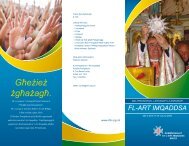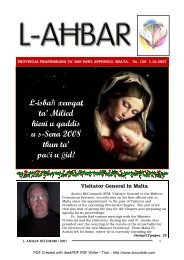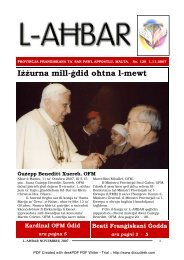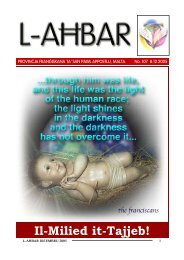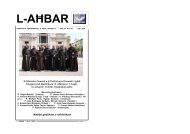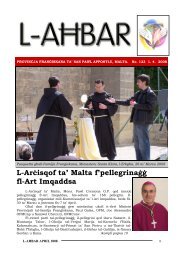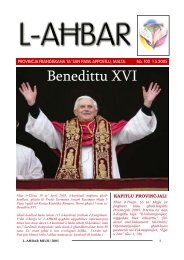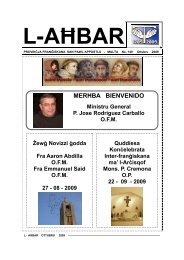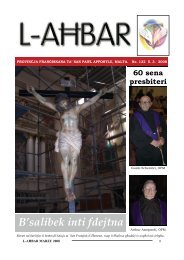L-AHBAR APRIL 2004 - Franciscan Province â MALTA
L-AHBAR APRIL 2004 - Franciscan Province â MALTA
L-AHBAR APRIL 2004 - Franciscan Province â MALTA
You also want an ePaper? Increase the reach of your titles
YUMPU automatically turns print PDFs into web optimized ePapers that Google loves.
PROVIN~JA FRAN{ISKANA TA’ SAN PAWL APPOSTLU, <strong>MALTA</strong>. No. 91 01.04.<strong>2004</strong>L-G[id it-Tajjeb!L-A{BAR <strong>APRIL</strong> <strong>2004</strong> 1
. MissionRevitalising the spirit of and interest in “ad gentes”missions in the <strong>Province</strong>s* Arousing and accompanying new missionary vocations* Offering suitable training for the new Friar missionaries* Promoting the missionary projects of the Order and<strong>Province</strong>s* Collaborating with the Study Centres of the Order,with the <strong>Franciscan</strong> Family and with other missionaryInstitutes.ACTIVITIESa. Evangelisation1. Informing and making the Provincials and GeneralVisitators sensitive to the matter:* by presenting the proposals for evangelisation of theOrder* by stimulating initiatives of formation for a <strong>Franciscan</strong>evangelisation* by helping to organise provincial plans for evangelisation* by encouraging the restructuring of the provincial Secretariats for evangelisation, in accordancewith the new General Statutes.2. Aids* a profound and didactic commentary on the V Chapter of the General Constitutions* sspecial aids concerning the above mentioned priorities* use of space in Fraternitas to provide information on evangelisation* renewal and feeding of the internet site of the Order regarding the General Secretariat froEvangelisation.3. Congresses* a congress on evangelisation in general, preferably by cultural areas (during first threeyearperiod)* an international congress on missionary evangelisation (second three-year period).4. Coordination and animationn* calling together the International Council for Evangelisation and its Executive Committee* accompanying the Provincial Secretaries for Evangelisation of the various Conferences intheir service* encouraging the institution of Secretariats and/or Interprovincial Councils for Evangelisationin each Conference of Ministers Provincial.5. Levels of collaborationThe Secretariat for Evangelisation collaborates with the General Secretariat for Formationand Studies, with the Commission for Dialogue, with the Office for Justice and Peace, withthe Office of Communications and with the Bursar General.6. The Organisation of the Secretariato* specialised library (books and magazines)* documentation centre on evangelisation in general and on missionary evangelisation* project of self-formation of the Secretariat Team: intense moments of reflection, prayer,recreation and exchange of experiences..b. Missions:1. Visits to the missionary projects of the Order, if possible with the presence of a GeneralDefinitor.2. Supporting the <strong>Franciscan</strong> presence in the Holy Land and Morocco in particular.3. Encouraging and organising missionary experiences for young temporary professed Friars.4. Encouraging missionary experiences for young lay <strong>Franciscan</strong>s also (You.Fra and SFO).5. Encouraging the establishment of some Fraternities on the missions (e.g., Africa andAsia) that would be prepared to receive and accompany the young Friars that would comeL-A{BAR <strong>APRIL</strong> <strong>2004</strong> 3
for a first missionary experience.6. Supporting the Fraternity “Notre Dame des Nations” in Brussels for the preparation ofmissionaries by:* organising two groups of missionaries each year at different times (September-December and February-May)* studying the possibility of opening the formation of missionaries to the <strong>Franciscan</strong>Family.* Studying the possibility of beginning a new Formation Fraternity (inter-cultural andRussian speaking) for the Friar missionaries destined for the countries of the Commonwealthof Independent States.* Studying the possibility of establishing something like a “<strong>Franciscan</strong> Missionary College”in a country of Latin-America to form missionaries destined for missionary territories of theContinent that are still without a <strong>Franciscan</strong> presence..* Supporting and animating the <strong>Franciscan</strong> Missionary Union.* Encouraging the creation of international Fraternities with the specific aim of a <strong>Franciscan</strong>presence (e.g., a new kind of insertion, presence and testimony of respect for creation,solidarity with the new poor, etc.).* Publishing “dossiers” of the <strong>Franciscan</strong> documents on missions, the Missionary Projectsof the Order, the <strong>Franciscan</strong>s in Morocco and simple handy brochures on the missions.* Renewing the ties and collaboration with the <strong>Franciscan</strong> Missions in Waterford (USA).A COMMUNICATION ON THEATTACKS IN MADRIDRome, 15.03.<strong>2004</strong>While it is still difficult for us to believe thepictures we have seen and all that we haveheard and read in the mass media of communications,we, the <strong>Franciscan</strong> Friars Minor atthe General Curia in Rome, add our voices tothat of very many other men and women ofgood will in condemning the brutal crimecarried out in Madrid, which has caused somany innocent victims.We do so with the voice of Francis of Assisi, a weak voice, but one that is strong through the powerof the Gospel. In the name of God, in great humility -"kissing your feet"-, but with the strength thatcomes from the cry of the innocent victims and of all men and women of good will, we ask all thoseresponsible for this act and all that feel the temptation to violence: to stop killing, to cease terrorismand not to give in to the temptation of hatred, violence and death. Let us all work tirelessly so that"wounds may be healed" (Is 57, 19) and "peace, like a river", may flow over all the land (Is 66, 12).Atthesametimeweprayto"theFatherofmercies"totakeallthosethathavediedintoHisarms,togive consolation and hope to the families of the victims and to transform us all into instruments ofpeace and reconciliation.On this occasion, we Friars Minor reaffirm our commitment to working tirelessly in the constructionof a "pacified" and "peace-making" world.Br. José Rodríguez Carballo, ofmMinister General of the Order of Friars Minor andthe Friars of the General Curia of the <strong>Franciscan</strong>s in Rome.L-A{BAR <strong>APRIL</strong> <strong>2004</strong> 4
families are torn apart because of illegal trafficking around the world. Very often, these traffickedpersons are sexually, physically, mentally, and economically exploited. They are the new slaves ofthe 21st century.Lord, you looked into the eyes of your mother and knew the anguish in her heart. May her love foryou reach out through us to all families experiencing broken, fearful hearts for the lives of their children.5: Simon helps Jesus to carry his crossA man who did not know Jesus- helps to share his burdenMany <strong>Franciscan</strong>s work and live with the poor and marginalised. Like Simon, these individuals andorganisations selflessly work for the promotion of human rights on all levels. They help relieve thesuffering of the poor and work to change structures that perpetuate the cycle of poverty.Lord, bless all of our <strong>Franciscan</strong> sisters and brothers who live and work with and for the poor at thegrassroots level and allow organisations like <strong>Franciscan</strong>s International to grow in their solidaritywith thepoor at the international level.6: Veronica wipes the face of JesusA compassionate woman from the crowd steps forward to ease Jesus’ painAccording to UNAIDS, 40 million people, globally, are HIV positive, leaving 13.2 million childrenorphaned by AIDS. In some countries of Southern Africa, 36% or more of all adults are living withHIV and/or AIDS. Many <strong>Franciscan</strong>s work on the front lines of this pandemic, serving in hospitals,parishes, and community centres.Lord, thank you for our compassionate sisters and brothers who work tirelessly to create supportivecommunities for HIV/AIDS patients. Let us all work to increase discussion within church communitieson the issues of stigma and discrimination.7: Jesus falls for the Second TimeJesus is again overwhelmed by the burden of the cross and falls a second timeThe burden of poverty affects billions of people, leaving many denied their basic human rights to:life, food, access to clean water, participation in government, adequate housing, basic education,healthcare, and sanitation, making it difficult to think of a positive future.Lord, raise the eyes of the broken to a new future. Let us become more attentive to the silent sufferingof the most poor.8: Jesus consoles the women of JerusalemAgain, Jesus found the strength to console, despite his own sufferingFor the past 12 years, the people of Togo in West Africa have been living in a state of profound crisis.Peace is often lost within a chronic state of material and psychological poverty. There is a growingunrest due to the desperate political situation. The situation in Togo, among many others, is oftenunheard of by the majority of the world.Lord, you told the women not to weep for you, but for the peoples of the world. Let us console ourAfrican sisters and brothers by using every opportunity available to speak out against unjust governments.Let our voices be heard in community meetings, newsletters, letters, and simple conversations.9: Jesus falls for the third timeWeakened, Jesus falls another timeIn a globalised world, many companies have expanded within developing countries, often adverselyaffecting the economies and the environment of the poorest of the poor. Several transnational corporationshave not only destroyed the forests, tainted the water supply, and negatively contributed to airpollution levels in developing countries, but have disappeared healthy human communities.Lord, we pray for companies and government leaders whose decisions affect the global economy andenvironment. Let them make choices which encourage the sustainable development of all peoples. Letus believe that our own communities can make a positive impact on the environment.L-A{BAR <strong>APRIL</strong> <strong>2004</strong> 6
10: Jesus is stripped of his clothingJesus is stripped not only of his garments, but also his dignityDue to extreme poverty and war, many people all over the world are forced into migration, leavingtheir homeland with little belongings and security. This vulnerable population of migrants and refugeesare received with discrimination and hatred and stripped of their basic human rights and dignity.Lord, let us open our minds and hearts to those who are different from us. Allow us the courage andwisdom to stand up for migrants, displaced persons, and those without a home in our own communities,until we all live in freedom with basic rights.11: Jesus is nailed to the crossJesus is nailed to the cross with a heart of forgiveness toward his perpetratorsToday, <strong>Franciscan</strong> sisters and brothers are caught in the middle of intense religious and ethnic strugglesin the Holy Land, Pakistan, and Indonesia. They live surrounded by armed groups and work consistentlyto create dialogue while avoiding terror. They are marginalised and overshadowed, the forgottenvictims in the current political crisis in the Middle East.Lord, we cannot begin to imagine the pain your people feel, living with deep, cruel scars. Let us andour Christian sisters and brothers work to encourage a peaceful settlement with and through justmeans, accompanied by a culture of reconciliation not only in the Middle East, but all over theworld.12: Jesus dies on the crossJesus cried with a loud voice and called up his spiritToday, many voices are yelling out in suffering from acts of torture. Torture occurs today in morethan 100 countries. Torturers continue to use unspeakable forms of violence to get victims to providethem with a desired confession. Often, the victims try to separate their mind and heart from the painthey are feeling.Lord, remind the victims of torture that you are there with them, taking on their pain. For people whosuffer and die with you- may they share in the loving peace of your heavens. Let our compassion andmourning for victims of violence transcend the distance that often separates us.13: Jesus is taken down from the crossThe friends and family of Jesus weep as they place him in the tombVillages in El Salvador, Rwanda, Guatemala, Croatia, the Democratic Republic of the Congo, andmany other places have been entirely massacred in the name of justice. Many <strong>Franciscan</strong>s preparemass gravesites for these massacres that often go unknown for decades. They suffer with the forgottenpeoples and struggle with the burial of close friends who die as martyrs just for speaking thetruth.Lord, so many people are standing by gravesides today, feeling hopeless and fearful, wondering howto rebuild a life in your love. Let us show them your saving grace and renew their convictions thattheir loved ones are free from pain and fear.14: ResurrectionBy Jesus’ cross and resurrection, he has set us free. God is the Saviour of the world!<strong>Franciscan</strong> communities and organisations all over the world work to provide witness to the paschalmystery. <strong>Franciscan</strong>s run schools, hospitals, JPIC offices, shelters, and specialise in many other servicesthat serve the poor. Their dedicated service in the spirit of Francis and Clare renews the hopeand faith that is resurrection!Lord, for all of the Christian communities that celebrate everyday your passion, death, and resurrection.May they become an active sign of the new life you bring to the world. Thank you Jesus forleading us from the darkness and into the light<strong>Franciscan</strong>s InternationalL-A{BAR <strong>APRIL</strong> <strong>2004</strong> 7
Devotioal iconography and other traditionsduring Holy WeekCharles ColeiroEASTERTIDE in the Maltese Islands is avisible cycle marked by an amalgamationof religious beliefs and spectacular pageantry.Few other local traditions show the same signs ofvitality, change and motion as that of the GoodFriday processions with life-sized images repreentingthe main events of the Passion and Deathof Christ and forming a characteristic feature ofHoly Week celebrations in these islands.Various influences have been at work inshaping this tradition. The original impulse camefrom the <strong>Franciscan</strong> Friars, popularly known asthe Minors, who not withstanding the ravages ofpresent day sectarian conflicts still have closeconnections with pastoral work in the Holy Landand carry out specific activities centering aroundthe Holy Sepulchre.There was also a direct influence fromreligious customs in Spain extended toanalogous traditions in Sicily where similar processionsintroduced on the pattern of the Genoesecasazze in the 16th century were gradually elaboratedunder Spanish control during their period ofdomination. 1Moreover, the Maltese Church's dependenceon the diocese of Palermo up to 1807 mayaccount for the close parallels met with variouslocalities in neighbouring Sicily. By the end ofthe 16th century, the Guild (of St. Joseph linkedwith the <strong>Franciscan</strong> Minors of Rabat was the firstto organise such a procession in Malta followedby its counterpart, the Guild of the Holy Crucifixat the Valletta Friary. According to the statutedated 1647, a procession on Good Friday had alreadybeen mentioned. 2Historic anecdotes recall that in the early yearsof the 18th century some merchants and sea captainsfrom Vittoriosa happened to witness a processionin a Spanish town on Good Friday andthis experience prom-pted them to commission asimilar set of statues for the parish church of theirnative city. Some of these effigies known asmanikini draped in fine cloth, still exhibit theirfaces, hands and feet made of papier mache andup to living memory were kept in the privatehomes of wealthy families, in Vittoriosa, whoseancestors had cont-ributed towards their expenses.3The 18th century saw a progressive increase inthe number of localities staging these processions.By 1795 the custom had spread fromVittoriosato Senglea and Cospicua (c. 1700), Zejtun(c. 1740), Naxxar (c. 1750), Qormi (c. 1764),Gharghur(c. 1792) and Luqa (c. 1795).Similar progress was recorded in the 19 th century.Between 1800 and 1866 processions withife-sized statues were intro-duced in Victoria (c.1809). Ghaxaq (c. 1830) and Mosta (c. 1866).between 1900 and the outbreak of the SecondWorld War no further development took place inMalta.The scene, however, shifted to Gozowhere to the one procession held at Victoria (anda separate manifestation inaugurated in 1968)were added those of Nadur (1913), Xaghra (1914)and Zebbug (1919). From 1921 onwards a set ofstatues appeared at Xewkija but they were nottaken out in procession with the exception of thePieta group, which has developed into a pageanton the Friday known as the day of Our Lady ofSorrows.Since the end of the last war a tokennumber of statues appeared at Christ theKing's Parish Church in Paola, increasinggradually after 1944 to the traditional eightand adding more statues afterwards. Inother churches in Malta a number of statues haveeither been replaced by others or added to theoriginal images. It seems the Parish Church ofQala in Gozo - with the inauguration of statuarygroups year after year - may one day organise itsown Good Friday procession.As specimens of Maltese popular art, these Passionepisodes represent the highest form achievedin the papier mache technique, which is believedo have been introduced to Malta by an unknownlay brother from Sicily. A Maltese barbersurgeon.Saverio Laferia who practised art as aideline, successfully used the technique between1739 and 1742 when he worked on Good Fridaytatues for the <strong>Franciscan</strong>'s Ta' Giezu Church inValletta.Many local artists have popularised this techniquesince the 18th century. The best known wasSenglea-born Karlu Darmanin (1825-1909) andin our times Wistin Camilleri in Gozo. Who bestowedhis talents on his sons. Alfredchael.and Mi-L-A{BAR <strong>APRIL</strong> <strong>2004</strong> 8
sides, these papier mache statues, whichare veritableobjets d'art which belong to the religiousBaroque of Spain and Southern Italy, similar effigiescarved in wood are on display on Good Fridayin Maltese churches.Special mention is made of the two artistic statues at Vittoriosa, the Scourging at the Pillar andEcce Homo, better known in the vernacular as II–Marbut and II-Porpra respectively. Both statueswere modeled and executed by the eminent Maltesesculptor Salvatore Psaila in 1831. Likewise,II-Marbut at Ta' Giezu Churchin Valletta is a masterpiece inwood by another Maltese,Pietro Paolo Azzopardi whoalso adorned the processionalsanctuary group at St George'sBasilica in Gozo with a devotionaland artistic crucifix, aprominent figure of the Vara1-Kbira.Tracing old times, onceagain, at Vittoriosa there wereoriginally three processionsduring oly Week, the first oneon Wednesday (L-Erbgba tat-Tniebri) proceeded from thechurch of Our Lady of MountCarmel with the participation of crews from theOrder's galleys includingbaptised slaves and persons condemned for variouscrimes to wear iron chains. 4 These forzati hadto carry the Crucifixion group shoulder high,compelling them to rest at every 20 or 30 paces.In our times one can still watch participants, inthe Mosta and Naxxar procession, dragging ateach heel a tremendous length and weight of ironchains. a kind of penitential or votive practiceinherited from the era of the Knights.Chain-dragging fratelli can also be seen duringthe traditional procession from St George's Basilica.This manifestation has indeed retained itsoriginal simple and devotional status without thepomp and parades marking most of today's processions-turned-pageants.The second procession at Vittoriosa came outfrom the Church of the Annunciation, on MaundyThursday and the third, which was by far themost important and in which the Jurats of thatcity look part, proceeded from the parish churchof St Lawrence on Good Friday. The Greek Papasled another procession on the same day.5Half way through the 19th century, GeorgePercy Badger, an English author who is synonymouswith his pen-portrait of Malta during histime, described the procession in Valletta: "Therain leaves the church of Ta' Giezu a little beforesunset, the fratelli and friars walking in file oneach side of the street with huge lighted wax tapersin their hands, and chanting as they followthe statues which are carried before them at equalistances in the procession. These images are ingeneral of a large size, and represent the varioussufferings of the Saviour until He is laid in thesepulchre, which is a splendid canopy with richcurtains tessellated with gold,having figures as large as life,stretched beneath them. Aftertraversing several of the streets,the procession re-enters thechurch." 6The first Good Friday processionsprogressed till very late at night,but in 1879 Bishop Scicluna orderedthat henceforth all processionswere to be back in churchby8p.m.Healsoorderedthatthese should only be held onGood Friday and also withdrewpermission for band playing during(he processions. Due tostrong protests and public outrage bands wereonce allowed to lake part.The list of anecdotes relating to Holy Weektraditions and religious folklore is endless, hut noresearch study on the theme of devotional iconographywould be complete without at least givingan honourable mention to two historic imagesdeeply rooted in the religious beliefs of theMaltese people. The sacred effigy of Christ theRedeemer venerated at Senglea Basilica needs nointroduction. The statue, which attracted the faithfulto its niche as early as 1681, establishes a livingway of the Cross through the streets of Sengleaevery time the Redeemer leaves His sanctuary.Another crowd-puller during Holy Week and indeedall year round is the miraculous effigy of theCrucifix, Il-Kurcifiss ta' Giezu at the <strong>Franciscan</strong>Church in Valletta. This crucifix was already reered by the faithful "with much fervour and devotion"as early as 1667. 7 Although history booksregister the Crucifix was the work of the saintlyFra Umile who died in 1639, tradition has it thathe crowned head was shaped through divine intervention.8 ikompli pagna 22L-A{BAR <strong>APRIL</strong> <strong>2004</strong> 9
ITTRA TA’ APPREZZAMENT MILL-MISSJUNARJI FIL-LIBYABro. Paul Galea,OFMProvincial Minister<strong>Franciscan</strong> <strong>Province</strong> of St. Paul the ApostleValleta VLT 07 <strong>MALTA</strong>Dear Bro. Paul,May the Lord Give You Peace!We, the <strong>Franciscan</strong> friars here in Libyawould like to convey to you and to theentire Provincial fraternity our heartfeltthanks for a fruitful and meaningfulretreat and on-going formation youorganized for us. Everything wentsmoothly and according to plan, startingfrom our arrival until our departure.Indeed it was a real experienceof true joy and brotherhood for us tobe with our brothers there in Malta forthe first time in the history of Libyanmission. We really achieved more than the objective we set for this retreat.We would like to inform you also of the result of the evaluation and reflection of the friars here inTripoli about this retreat when we had our House Chapter last March 13, <strong>2004</strong>. First of all on thequestion of “What I like most in the retreat?” our responses were: good fraternity, well-planned andorganized retreat, very good input and facilitators, nice atmosphere and accommodation, hospitableand generous brothers, friars spent much time for us, opportunity of watching “Malta Experience”and the movie “Passion of the Christ”, good places and delicious food especially the ones prohibitedin Libya like pork and wine, beautiful churches and convents, friendly people, time spent with thefriars in different communities, visit the old and sick friars specially Benjamen. Reflecting on themessage and insight God gave us through this retreat, we enumerate them as follows: purified ourheart and spirit in doing mission in Libya, renewed our <strong>Franciscan</strong> spirit and whole being, enkindledin the self <strong>Franciscan</strong> spirituality of doing mission, re-energized us to continue our work, challengedus to work more and hard for the mission in Libya, different places in Malta and input of the friarsreminds us of how the early Christians and <strong>Franciscan</strong>s work hard to preach the Gospel and challengedus to do the same, saw the importance of communication and fraternity between friars inLibya and Malta, good beginning of friar’s collaboration regarding on-going formation that will helpsustain spiritual and pastoral works of the friars here in Libya. Our recommendation then is to continuethis kind of program at least once a year for all the friars here in Libya in different places tochoose from like Egypt, Italy, Malta or other places of <strong>Franciscan</strong> friars.Finally we would like to ask your opinion on how we will handle the applicants approaching us here who areinterested to become <strong>Franciscan</strong>s. As of now there are two, one Filipino and one Nigerian. Kindly inform uswhat to do.Fraternally yours,Melito Pinili,OFMCelso Larracas,OFMVirgilio Putskowski,OFMWilliam Abdel Nasseh,OFMRitratt fuq: l-Ahwa missjunarjimal-fraternita’ tal-HamrunL-A{BAR <strong>APRIL</strong> <strong>2004</strong> 11
Vicariatus Apostolicus"San Francesco "Catholic ChurchP.O.Box 365TRIPOLI - Dahra - LIBYATel: 00218.21.3331863Fax: 00218.21.3334696M.R.P.Paolo GaleaFr. Provinciale ofmMalta 27.02.<strong>2004</strong>___________________M.R. e Caro Padre Provinciale,"Il Signore ti doni la Sua Pace!"Mi e gradito esprimerle la mia riconoscenza e la mia comunione per l'iniziativa diaccogliere e organizzare per i frati presenti in Libya un incontro che vuole essereun momento di riposo spirituale a Malta nella "casa francescana".Le fatiche apostoliche a cut sono sottoposti quotidianamente i nostri fratellirichiede sempre nuove forme per aiutarii a ricuperare fiducia in se stessi e nuoveenergie nella vocazione francescana per servire meglio anche la nostra Chiesa.Ho goduto delPiniziativa di fare un salto a Malta per conoscere meglio i fratelli ofmmaltesi e godere della loro generosita, ospitalita e rifocillarsi spiritualmente.Son sicuro che sara 1'inizio di nuovi fecondi rapporti tra le due fraternita, maltesee libica...Desidero ringraziaria inoltre di aver mandato P.Lito all'incontro dei frati in Egitto.Ne e ritornato entusiasta per aver conosciuto tanti frati, stabilito nuovi rapporti inEgitto e con il nuovo staff dell'Ordine. Anche in Curia hanno espresso il desideriodi passare appena possibile in Libya quando eventualmente il P.Generale sara aMalta... In Sha' Allah! Se Dio Vuole.Quando ci sono nuove occasioni di incontri dell'Ordine a cui possono partecipareanche i frati della Libya e bene inviarii per motivarii sempre piu alia missione.Caro Padre Paolo auguri di ogni bene per il suo servizio alia famiglia francescanain Malta e Libya.Le assicuro la mia preghiera mentre invoco di cuore la benedizione divina su voitutti.Con fraterno affetto e stimaSuo Dev..mo in Cristo e S. Francesco+ Fr. Giovanni Martinelli ofmL-A{BAR <strong>APRIL</strong> <strong>2004</strong> 12
DIRETTUR :DID TA’ L-APPOSTOLAT TAL-BA{ARMons. Ar/isqof :u]eppi Mercieca [atar lil Fra PaulAttard OFM, b[ala Direttur ta' l-Appostolat tal-Ba[aru Rettur tal-Knisja ta' Liesse, il-Belt. Din in-nominatfisser ukoll li huwa l-Kappillan tal-portijiet, kif ukollmembru tal-Kunsill tas-Segretarjat g[all-Emigrazzjoni u Turi]mu. Fid-dinja hawn aktar minn20 miljun ba[[ar. L-ufficcju ta' l-Apostolat tal-Ba[arjinsab Stella Maris, 62,Liesse Hill, Valletta.Fra Paul wettaq diversi[idmiet pastorali kemmf'Malta u barra. Hu ta' s-servizz f'Vittoria, Sqallija, kifukoll f'Toronto, il-Kanada,kemm b[ala vi/i kappillan u anke b[ala kappillan tal-komunita' Maltija.F'Malta huwa [adem b[ala vi/i kappillan fil-parro//a tal-Madonna tas-SacroCuor u f'Ba[ar i/-aghaq. Attwalment huwa jifforma parti mill-fraternita' tal-{amrun u qed ikompli jag[ti s-servizz tieg[u lid-drogati, lill-pri;unieri(S.A.T.U, il-Ba[rija), g[alliem u religious counsellor fil-Kulle;; De LaSalle, Bormla.SYMPOSIUM DWAR MADRE MARGERITA DE BRINCATNhar is-Sibt, 20 ta' Marzu <strong>2004</strong>, fl-okka]joni tal-prezentazjoni tal-Positio fil-Kongregazzjonighall-Kaw]i tal-Qaddisin tal-Fundatri/i tas-Sorijiet Fran;iskani tal-Qalb ta' Gesu' Madre MargeritaDe Brincat sar Symposium fi/-?entru Animazzjoni u Komunikazzjoni.Barra l-kant, il-programm tas-Symposium kien jinkludi diversi diskorsi. Il-Professur OliverFriggieri tkellem dwar Il-Qaddejja ta' Alla Madre Margerita fl-isfond Malti ta' ]mienha. Fra MarcelloGhirlando OFM, fl-assenza ta' Fra Noel Muscat, OFM li jinsab imsiefer fuq servizz ta' l-Ordni, qarad-diskors li [ejja Fra Noel dwar L-Ispiritwalita' Fran;iskana ta' Madre Margerita. u Fra PierGiuseppe Pesce, OFM g[amel diskors dwar il-Contemplazione e apostolato nella vita di Madre Margerita.Filwaqt li s-Symposium kien ta[t il-presidenza tas-Superjura :enerali Sr. Anselmina Mifsud,FCJ, il-kant kien immexxi minn Sr. Aniceta Briffa u l-pre]entazzjoni tas-Symposium saret minnFra :or; Aquilina, OFM.Il-positio huwa ;abra tal-materjal kollu ori;inali li je]isti dwar il-[ajja, l-opra li waqqfetMadre Margerita u l-ispiritwalita' tag[ha. Fl-istess positio hemm ukoll studji diversi dwar kif g[exetdak li kitbet. Il-Kongregazzjoni g[all-Kaw]a tal-Qaddisin g[ad trid ta[tar tmien /ensuri u kullwie[ed minnhom jo[ro; studju u jag[ti l-vot tieg[u jekk verament Madre Margerita g[exitx ilvirtujietfi grad erojku. Issa g[addew 17 il-sena minn meta nhar is-27 ta' Jannar 1987 il-Kongregazzjoni tat il-permess lill-Isqof ta' G[awdex Mons. Nikol Cauchi biex seta' jifta[ il-pro/ess uwara [afna xog[ol ing[alaq nhar it-22 ta' Jannar 1999. Dan ix-xog[ol kollu kiseb vot affermattiv tal-Kongregzzjoni fl-1 ta' Dicembru 2000.Fost dawk pre]enti g[as-Symposium kien hemm it-tliet Ministri Provin/jali Fran;iskani, fosthomFra Paul Galea, OFM?elebrazzjoni Penitenzjali g[and il-KlarissiNhar it-Tlieta 23 ta’ Marzu, b[ala parti mill-attivitajiet fl-okka]joni tas-750 sena mill-mewt ta’Santa Klara, l-a[wa tal-provin/ja flimkien ma’ [utna s-sorijiet //elebrajna servizz penitenzjali filmonasterutag[[om. Il-Ministru Provin/jal Fra Paul Galea, ofm mexxa /-/elebrazzjoni.L-A{BAR <strong>APRIL</strong> <strong>2004</strong> 13
DAWLFIDDLAMDawlfiddlam huwa l-isem tad-dramm originali ta’ :wann AbelaOFM li SKENE se tippre]enta fit-Teatru Metanoia (Luqa) g[al ]mien il-:img[a Mqaddsa. Dan id-dramm se ji;i ppre]entat is-Sibt3 t'April, il-{add 4 t'April, l-Erbg[a 7 t'April u l-{add 11 t'Aprilfis-7.30 pm.Dawlfiddlam huwa xog[ol differenti g[al kollox mid-drammi tradizzjonalital-Passjoni. Fil-fatt dan id-dramm jo[ro; rasu biexjilma[ il-[]u] ;ewwiena ta' poplu fil-mixja lejn il-kisba tal-fer[.Im;arrbin huwa le[en li fis-sikta u l-[emda ta’ so/jetà kontemporanjadonnu jitla’ mill-qieg[ tal-qalb ta’ min jinsab ifittex id-dawlfid-dlam tal-[ajja u mhedi jew im;arrab minn il[na li joffrulu ujbieg[ulu l-illu]jonijiet jinsa s-sens tassew tal-[ajja. Huwa ;rajjafejn it-tra;edja tnissel mi]erja u aljenazzjoni siekta. Quddiem danid-dramm uman tfi;; fix-xefaq il-;rajja tas-Salib li fuqu mdendelg[all-mewt l-Iben ta’ Omm imnikkta li jokrob ukoll bl-u;ieg[ talmewtu t-tbatija. Dan kollu jag[mel minn dan ix-xog[ol l-aktardramm originali g[al ]mien il-:img[a Mqaddsa <strong>2004</strong> fil-gzejjerMaltin.Il-qawwa ta’ Dawlfiddlam tikber u tissa[[a[ bil-[oss tal-mu]ika li tiddomina mill-bidu sat-tmiem.Jiddominaw [sejjes ta’ mu]ika li takkumpanja u tmexxi l-;rajja. Mu]ika moderna, f’sa[[itha, litesprimi l-[]u] ;ewwiena tal-;rajja nnifisha. Il-muzika hija l-muftie[ tal-esperjenzi, l-benniena lit[annen lill-atturi li jesprimu lilhom infushom ukoll bil-kant ta’ poe]iji mirquma. Imma Dawlfiddlamhija wkoll sfida li tpaxxi l-g[ajn fejn l-ilwien u d-dwal jisplodu f’idejn il-gruppi ta’ “]effiena” li ju]-aw l-ispazji kollha tal-palk [a jmexxu lill-udjenza f’din l-esperjenza teatrali. U dan kollu “live”, millmu]ikasal-kantanti... mg[ejuna minn tekni/i professjonisti li jiffurmaw parti minn SKENE.Dawlfiddlam g[andu mu]ika ori;inali (live) miktuba apposta mill-grupp mu]ikali ta' SKENE (JamesGalea, Josef Farrugia, Patrick Camilleri, Eric Camilleri, Silvan Saliba-Butler). Kantanti (fosthomEleanor Cassar) li se jkantaw live numru ta' kanzunetti u spettaklu ta' lwien mg[agun ma' korjografijasempli/i imma effettiva. Jie[du sehem fost l-o[rajn Andrè Penza, Raymond Darmanin, Eleanor Cassar,Tiziana Calleja, Patrick Vella, Brian Galea, Mark Mifsud u Sandro Farrugia. Id-direzzjoni hijata’ l-awtur innifsu, :wann Abela ofm. Booking miftu[ (tel. 21806712).ikompli minn pagna 13Iconography related to the Maltese HolyWeek is only part of a long list of anecdotes andpopular beliefs enshrined in the religious folkloreinheritance of these islands.Surprisingly, reverence and profanity, faith andtradition produce a vivid co-existence in the calendarof religious events, that has to be witnessedrather than narrated.Mr Charles Coleiro is the author of thebook Il-Festi Taghna, an analysis of events, religiousbeliefs, and customs related to the Maltesefesta from its introduction in the Maltese Islandsto present times. (Publikazzjonijiet Indipendenza2003).References1 and 3. G. Cassar Pullicino, Lecturenotes on Maltese folklore (1990).2. Gorg Aquilina OFM, U-Gimgha 1-Kbira fit-Belt, Ed Tau (1986).4 and 5. Lorenzo Zahra II-purcissjoni-jiet tal-Gimgha 1-Kbira, Taqsima Il-Birgu, PIN (1992).6. G.P. Badger Description of Malta andGozo,Malta(1839).7. Pietro Tognoletto OFM, Cronica,Palermo (1667) p. 309.9 Ibid, op. cit.. p. 308.According to some historians writing on HolyWeek traditions, opinions differ from one anotherregarding the year of the first processions in thelocalities mentioned in this article.THE SUNDAY TIMES, MARCH 21, <strong>2004</strong>L-A{BAR <strong>APRIL</strong> <strong>2004</strong> 14
{ONDURAS}JARA FRATERNA TAL-MINISTRU PROVIN?JALBARRA MINN <strong>MALTA</strong>TORONTORapport ta]-]jara fraterna u aktar ritrattifil-[ar;a li jmiss ta’ l-A{BARB[ala parti millprogrammtalformazzjonipermanentili l-provin/jaorganizzat matul ir-Randan ta’ din is-sena,nhar il-:img[a, 26 ta’Marzu saret l-a[[ar laqg[a fi/-?entru San Fran;iskil-{amrun.Il-laqg[a tmexxietminn Fr. Paul Pace,S.J. fejn tkellem dwaris-sitt valur tas-SinoduDjo/esan, ji;ifieri l-Qadi u s-Solidarjeta’.L-A{BAR <strong>APRIL</strong> <strong>2004</strong> 15
F’ DIN IL-{AR:AApril <strong>2004</strong>General Plan For The Six Year 2PeriodKomunikat mill-Ordni 4The Way of the Cross:A Universal Reflection on Christ’sDying and Rising 5Devotional iconography and othertraditions during Holy Week 8FESTI U BIRTHDAYS <strong>APRIL</strong>/MEJJU 2 0 0 4A P R I L23. Fra {or[ Aquilina 1. Fra Dijonisju MintoffFra George Bugeja 2. Fra Loreto Zerafa25. Fra Mark Enriquez 3. Fra Twanny ChircopFra Mark Ciantar4. Fra Joe Bonello30. Fra {u\epp Beneditt Xuereb 12. Fra Marcello Ghirlando19. Fra John Muscat23. Fra {uzepp Camilleri24. Mons. Robert CamilleriM E J J U3. Fra Alexander Borg 7. Fra Charles DiaconoFra Sandro Overend8. Fra Mark Enriquez12. Fra Godfrey Micallef 27. Fra Raymond Falzon19. Fra Ivo Tonna20. Fra Bernardin Sant27. Postulant Tyrone GrimaAwguri u Xewqat Sbie]!Fraternitas 9Esperjenza f’Malta ta’ [amesmissjunarji fran;iskani fil-Libja 14Informazzjoni 17EDITURfra marcellino micallef ofmprovofm@vol.net.mtKunvent Tal-Fran[iskani291, Triq San Pawl,Valletta VLT 07Tel. 21238218 Fax. 21231266L-A{BAR <strong>APRIL</strong> <strong>2004</strong> 16







